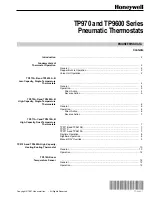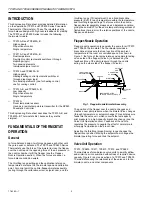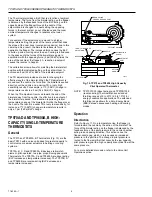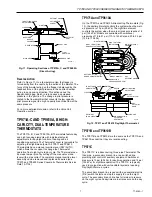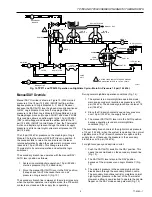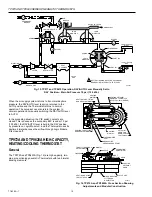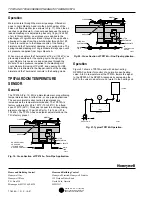
TP790 AND TP9600 SERIES PNEUMATIC THERMOSTATS
9
77-9382—1
Fig. 14. TP971 and TP9610 Operation on Nighttime Cycle—Main Air Pressure 18 psi (124 kPa).
BLEED 1
F
FILTER
RESTRICTOR
R
VALVE
UNIT
SECONDARY
BRANCH
S
1
1
S
S
B
DAY/AUTO LEVER
MANUAL DAY
LOGIC
MODULE C
LOGIC
MODULE D
SPRING
LOGIC MODULE A
DOTTED LINES INDICATE THE SECONDARY
BRANCH LINE INTEGRAL TO THE TP971C
BRANCH LINE
MAIN LINE
PILOT
CHAMBER
SPRING
BLEED 2
DIAPHRAGM
PORT B2
PORT B1
13 PSI (90 kPa)
DAY
18 PSI (124 kPa)
NIGHT
LOGIC
MODULE B
C6059-1
B
Manual DAY Override
Manual DAY Override is shown in Figure 15. With main air
pressure at the 18 psi (124 kPa) (NIGHT) setting, airflow
applies pressure to Logic Modules A, C, and D. However,
because the DAY/AUTO lever has been manually positioned
to DAY, Logic Module D is shut off, stopping airflow. Air
pressure is bled from Logic Module B through Bleed 2, and
the diaphragm moves up to open Port B1 and close Port B2.
This condition allows an airflow path to the 13 psi (90 kPa)
(DAY) nozzle-flapper and closes the airflow path to the 18
psi (124 kPa) (NIGHT) nozzle-flapper. Thus, the Thermostat
works on a daytime cycle even though the main air supply
pressure is at its normal night cycle main air pressure of 18
psi (124 kPa).
The 18 psi (124 kPa) pressure on the diaphragm of Logic
Module C holds the manual DAY/AUTO lever in position. If
the occupant fails to return the override lever, the lever
returns automatically when the system main air pressure is
reduced to 13 psi (90 kPa). This change returns the
Thermostat to its normal operation and automatic logic
switchover.
The secondary branch line operates with the manual DAY/
AUTO lever position as follows:
1. System in normal daytime operation, 13 psi (90 kPa)
main air pressure (Fig. 13 dotted lines).
2. Move the manual DAY/AUTO lever to the DAY position.
It snaps back to AUTO because there is no air
pressure on logic switch C (Fig. 13).
The secondary branch line is always at the main air pressure
when the system operates in a daytime mode; the P/E switch
contacts are closed and the supply fan is operating.
During normal nighttime operation conditions (Fig. 14):
1. The system is in normal nighttime operation mode;
main and secondary branchline air pressure is at 18
psi (124 kPa). The secondary branch line is also at 18
psi (124 kPa).
2. Since the P/E switch contacts open at any pressure
over 15 psi (103 kPa), the supply fan is off.
3. The manual DAY/AUTO lever is in the AUTO position
because operation is under normal nighttime
conditions (Fig. 14).
The secondary branch line is at the night main air pressure
of 18 psi (124 kPa) when the system is operating in a normal
nighttime mode. The P/E switch contacts are open and the
supply fan is off because the pressure in the secondary
branch is over 15 psi (103 kPa).
For night occupancy and daytime control:
1. Push the DAY/AUTO switch to the DAY position. This
opens the nozzle-bleed on the secondary branch line
(Fig. 15).
2. The DAY/AUTO lever stays in the DAY position
because of the air pressure on Logic Module C (Fig.
15).
3. The main air pressure in the secondary branch line
bleeds down through the secondary branch nozzle.
The secondary branchline restrictor maintains normal
night system pressure in the rest of the Thermostat.
However, airflow is now diverted to operate the nozzle-
flapper on the DAY mode sensing element (Fig. 15).

